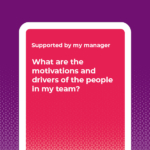How managers can increase motivation and job satisfaction within their teams
Businesses, their leadership teams and employees everywhere just had a tough couple of years, and it doesn’t seem like it’s about to get any easier. There are still plenty of new challenges on the horizon, including the cost of living crisis, and it can be hard for managers to keep their staff motivated and engaged.
So how can organisations help? By focusing on employee satisfaction. The new “Quiet Quitting” phenomenon is surfacing the fact that employees are becoming increasingly disengaged at work, and tensions between employees and employers are at their peak.
On the one hand, organisations are forcing their staff to come back to the office, with some managers even going back to their previous micromanaging ways. On the other hand, employees had time to rethink their priorities and are now giving up on the idea of going above and beyond at work.
Engagement is an essential component of job satisfaction, and in a tight labour market where people have plenty of choice when it comes to where they want to work, organisations have to address this disengagement issue. And they have to do it now. So how can you ensure your people are motivated and striving for more? At Let’s Talk Talent (LTT), we think that when it comes to creating happiness at work, managers are your best asset.
This is why we’ve compiled a list of the top 7 ways managers can create job satisfaction in the workplace.
1. Reward and recognise great performance
We all know how important it is to be recognised for a job well done. In fact, 37% of employees identify recognition as the main factor that would drive them to “(…) produce better work more often.” And a staggering 79% of employees state ‘lack of appreciation’ as the main reason for leaving their role. A culture of recognition is a powerful driver that can lead to better staff retention, talent attraction and higher performance.
And the good news? You don’t have to wait for big projects to be delivered to recognise your team’s work. Do it often: celebrate small milestones as well as big ones. It’s also important to reward those who exhibit the types of behaviours you want to foster within your organisation, such as teamwork, accountability and effective communications. And don’t forget about the team members who consistently produce great work. Don’t take their performance for granted; make sure they know how valued they are within your team.
Organisations are starting to be quite creative with their rewards and recognition programmes. With many employees struggling with the rising cost of living, companies are coming up with innovative ways to reward their loyal talent pool for their work, from lump sums to counter inflation to wellbeing initiatives to help with the anxiety caused by financial struggles.
2. Empower employees
Research shows that in order to thrive, employees need to be empowered to do their jobs, not micromanaged. Managers therefore need to give their team members the freedom to make decisions on a daily basis and to try new things, even at the risk of failing. In order to do this, trust is essential. An employee will not take risks unless they know their manager has their back.
Leaders should therefore focus on developing a culture of empowerment, trust and psychological safety. You can do this by asking your people for their input and ideas, discussing how they would resolve an issue and coaching them to reach an acceptable outcome without giving them a ready-made solution.
3. Focus on employees’ wellbeing
Wellbeing has become a bit of a buzzword lately, but what does it really mean? “One of the most important things you can do to contribute to employees’ wellbeing is to allow them to unplug,” says Jo Taylor, MD at LTT. Respect their time at home, and don’t expect them to respond to emails or instant messages out of hours. And it’s not just about physical rest either. According to Dr. Saundra Dalton-Smith, humans need 7 types of rest in order to avoid burnout, and managers should help their employees recharge their batteries in as many ways as possible. From making sure working hours are respected (physical rest) to not overloading staff (mental rest), and providing opportunities for social interactions (social rest), go above and beyond when it comes to staff’s wellbeing.
And the best way for managers to do this? By role modelling those exact behaviours. Don’t reply to emails after hours or during your holidays, and focus on your own wellbeing above all.
4. Get to know your team members
We know that leaders are often time-poor. Between managing the people, processes and projects required to reach organisational goals and the other admin requirements in place, there is often little time left to get chatty over the water dispenser. However, getting to know your people is crucial in order to build meaningful connections, which in turn leads to better employee engagement.
Find out your people’s professional goals, their personal boundaries and what makes them tick. Do you know what they love to do, and hate to do? Explore their strengths and drivers as well so you can help them identify the right career progression opportunities, or modify their roles and responsibilities to help them contribute in an even more valuable way.
5. Encourage the career progression of your employees
As mentioned, managers are time-poor and priority is often given to live projects and urgent issues, rather than planning the future. But career development is a crucial motivation-generating factor for staff. People do need to feel stretched and challenged on a regular basis, or else disengagement sets in.
It may be scary to encourage team members to develop their career, as this could lead to their departure from the team (or the organisation). But as a manager, a clear focus on developing others is essential. Help staff identify their career goals, as well as the Skills, Training, Attributes and Relationships (STAR) they need to build to get there. Ensure they are aware of all the development opportunities available to them, from internal mobility to promotions and special projects.
6. Foster the kind of positive culture that leads to job satisfaction
The research is clear: teams with a high level of psychological safety perform better at work and are more engaged. Feeling comfortable to ask questions, share ideas or even make mistakes is important in order to create employee engagement, and groups that feel safe to do so have a lower turnover and better productivity. So how can you foster a culture centred around trust and collaboration? By becoming a guide rail for the team.
Ensure employees have each other’s backs, and call out behaviours which are counterproductive. Also ensure you role model vulnerability: ask questions often, and share those experiences you believe would be helpful to the team.
7. Be a human, not a robot
Being a manager is about making sure your employees have everything they need to perform at their best, feel engaged and contribute to the wider organisational goals. Modern managers are increasingly required to have strong soft skills, such as empathy, care and communication, while expertise is being de-emphasized.
“Management isn’t so much about qualifications or technical skills. These are important, but they are more of a hygiene factor. The real must-have is emotional intelligence (EQ),” says Jo.
How can managers develop EQ? There are ways to do this, and each organisation should develop their own model for leaders to build up those skills. Identify the Skills, Training, Attributes (behaviours) and Relationships needed to improve your EQ, and put together an action plan that will help you take your management style to the next level.
Conclusion
Whilst it’s true that facing the new ‘Quiet Quitting’ phenomenon can be a bit disheartening for organisations, there is some good news. Most businesses possess a strong asset already: a line-up of managers keen to see their employees motivated, energised and striving for more. So what’s the next step? How can businesses spring into action and utilise their managerial staff to galvanise the troops?
Just listen to your people, in the same way that you listen to your external customers. Create an employee experience that’s unique to your talent pool and not only answers their professional needs, but makes them feel engaged at work. And make sure managers are prepped and ready to get to know their team members, to encourage their career progression and to coach them in a way that makes them feel challenged on a daily basis.
At LTT, we understand the importance of happy and engaged employees, which is why we’ve created a few resources that may help you.
You can download our guide to how HR can support managers in your organisation checklist here.
If you’d like a handy reminder of the points mentioned above, download our ‘7 ways managers can create job satisfaction in the workplace’ checklist here.
Related happiness at work resources
- Have a look at the International Happiness at Work Week resources here.





